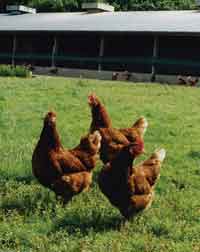Feed safety is crucial for poultry producers

Achieving effective control of pathogens has become increasingly important for poultry producers in recent years and feed safety plays a crucial role, as Poultry World reports
When it comes to biosecurity, feed safety is right up there near the top of the list, which is why one of the country’s leading regional egg producers has started specifying that all feed for its own and its suppliers’ free-range birds is treated with a permitted biocide.
“During the last few years the poultry industry has had to jump through an increasing number of legislative hoops,” says Bill Holmes, managing director of Lancashire firm J Rainford & Sons.
“No-one likes having to comply with even more red tape, but we have to recognise just how important it is for consumers to have confidence in the food products they purchase.”
With a laying site and packing station at its 46-acre Hatchwood site in Brindle, near Preston, the company is one of the largest producer/packers in the north-west, with 175,000 hens, approximately 18,000 of which are free range.
“As part of the National Control Programme (for salmonella) we are constantly working towards improvements in pathogen control and we now specify that all feed supplied for our own free-range birds, is treated with a biocide.
“We have taken this approach because we feel that birds kept in this type of environment are more likely to pick-up pathogen infections. We regard it as simply one more weapon in the biosecurity armoury and view the extra cost, approximately £5/t of feed, as additional insurance.”
Andrew Fothergill of BOCM Pauls, which supplies Rainfords, explains that the company has been incorporating Termin-8 – a well-established formaldehyde-based biocide – into its feed for many years. He has also seen increasing interest from forward-thinking producers, both in response to greater legislative pressures and because they recognise the need to protect their businesses against the risks from salmonella and other pathogens.
“Adopting a head-in-the-sand mentality is not an option when it comes to dealing with salmonella and, although the risk of an outbreak might be small, should that risk become a reality it could quickly turn into a major catastrophe,” he says.
“We believe that a far better solution, and one which we encourage producers to adopt, is to have feed treated. Termin-8 is already widely used in breeder diets, because it is essential to do everything possible to protect valuable stock. But we believe that it is very relevant for commercial flocks too, as layer feed is not routinely heat-treated.”
FOOD SAFETY – A HOT TOPIC
“Salmonella is a persistent problem which poses a major threat to humans who consume contaminated animal products,” says Simon Carlton of Anitox, a global provider of pathogen controls to the feed milling industry. “It cannot be entirely eradicated, and feed can be a factor in its introduction into the production chain.
“The EFSA Panel on Biological Hazards identified Salmonella spp as the major hazard for microbial contamination of feed, so producers should ensure that their feed supplier is addressing this important issue effectively.
“To help reduce the problem, feedstuffs delivered in bulk for layer, broiler, duck or turkey parent/grandparent stock are sometimes heat-treated. Apart from significantly increasing the cost of the feed, this process has a high carbon footprint, can damage vitamins/nutrients and may not kill all pathogens, particularly Clostridia perfringens, which can survive even very high temperatures.
“The fact that heat treatment has no residual effect also means that, unless other measures are implemented, re-contamination can occur in the mill, during transport or on-farm.
“EFSA has found that a formaldehyde-based feed treatment provides a viable alternative in treating feed, both initially and, crucially, in preventing recontamination. DEFRA-funded research which investigated the treatment of animal feeds with various organic acids and formaldehyde treatments, found large variations in efficacy and effects in masking the presence of salmonella during culture.
“The treatment which gave by far the best ‘kill’ of salmonella in feed was a liquid antimicrobial bacteriacide containing 33% formaldehyde, propionic acid and natural terpenes, a formula identical to Termin-8.”
